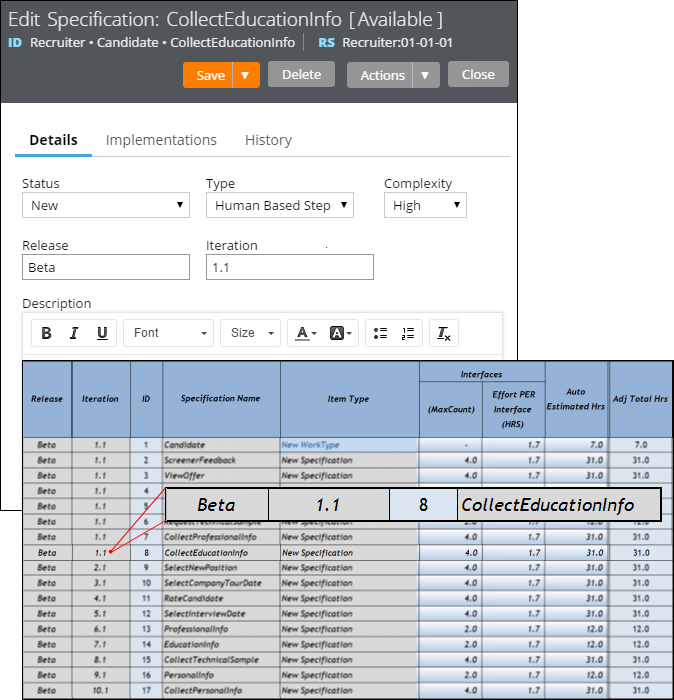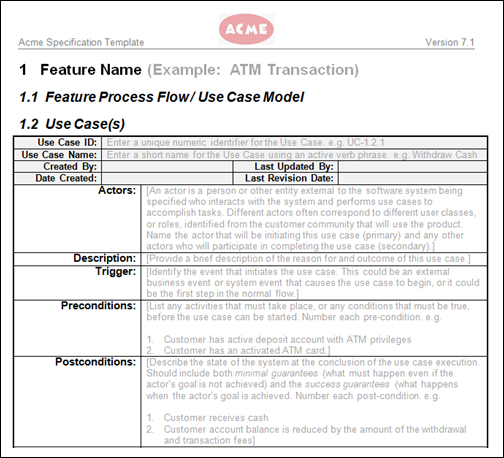Tracked changes persist between client sessions
Valid from Pega Version 7.1.7
The Microsoft Word native change tracking feature persists between client sessions for specifications. Enable this feature to facilitate collaborative reviews of your specifications with project stakeholders.
Inserting your specification updates as tracked changes allows you to:
- Provide visible markup to the next reviewer.
- Correlate edits to a specific user and time.
- Generate documents that include markup and comments.
Local settings, such as the colors you specify for markup, do not persist between clients.
For instructions on how to prevent markup and comments from appearing in generated documents, see Advanced options for editing specifications.
Add multiple attachments at once
Valid from Pega Version 7.1.7
You can now add more than one attachment to a requirement or specification at a time, without closing the Add/Edit Attachment modal dialog box. Use the traditional browse method to upload an attachment or drag and drop a local file, based on your needs. View and access your attachments from the Application Profile landing page, Requirement form, or Specification form.
Plan projects using release data
Valid from Pega Version 7.1.7
Requirements and specifications can now be mapped to a target release and iteration within a specific release. Populating these fields allows you to set and publish a release schedule through worksheets generated by the Sizing wizard. Access these fields from the Application Profile landing page or by opening any requirement or specification.

The Release and Iteration fields as they appear in a specification and a corresponding worksheet
The Sizing wizard incorporates values from the Release and Iteration fields for specifications only.
Specification type extended for decisioning users
Valid from Pega Version 7.1.7
Specifications now support a Decision Strategy Manager (DSM) type. This allows you to map your specifications to a decisioning component, such as a strategy or model. After you select an appropriate subtype and provide relevant metadata, you can run the Sizing wizard to incorporate these details into project sizing worksheets.

DSM specification details as they appear in the Specification form and Sizing wizard output
You must have access to Decision Management rulesets to create DSM specifications. For more information on specification types, refer to the Details tab of the Specification form. To view all specifications in your application, filtered by type, refer to the Application Profile landing page.
Add collections as linked implementations
Valid from Pega Version 7.1.7
You can now identify a collection or individual steps within a collection as an implementation of a specification. Linking specifications to rules allows you to more accurately convey your application design to project stakeholders. Use the Specifications tab on the Collection form to create these links.
To see all implementations for a given specification, refer to the Application Profile landing page or the Implementations tab of the Specification form.
Add project branding to generated documents
Valid from Pega Version 7.1.7
The standard Word Template for specification descriptions is now extensible. Using a customized template allows you to brand your generated documents with project-specific elements.
Specialize the Rule-Application-UseCase.pySpecificationDescription rule to:
- Include relevant images such as company logos.
- Define static text.
- Insert dynamic elements by merging clipboard values into field codes.

Generated document with custom company logo
Refer to Advanced options for editing specifications for instructions on how to override this template.
Conversation flow and smart shapes for the Digital Messaging chatbots
Valid from Pega Version 8.6
When creating Pega Intelligent Virtual Assistant™ (IVA) for Digital Messaging, chatbot developers can now use new conversation smart shapes in a dedicated flow, making the design process simpler, more robust, and intuitive. With the new smart shapes, the chatbot displays text messages or asks questions to users in one of several ways. In addition, developers do not have to create additional rules, switch tabs, or perform manual validation. You can associate the conversation flow that you create for your IVA with a business case, use the flow on its own, or reuse it in another conversation flow, improving the overall chatbot design process.
For more information, see Adding a stand-alone conversation process for a conversational channel, Adding a case type conversation process for a conversational channel, Editing the conversation smart shapes and Flow shapes.
Ability to forward emails in triage cases
Valid from Pega Version 8.6
When working on customer emails in the Email Manager or Case Manager portal, customer service representatives (CSRs) can now forward emails to additional stakeholders, for example, third-party vendors or sellers. As a result, CSRs that work with Pega Email Bot™ save time, improve responsiveness to customer inquiries, and make email triaging more efficient. The email bot keeps each forwarded email conversation in a separate email thread from the customer conversation, making the system more consistent and secure.
For more information, see Communicate with stakeholders on a customer query by forwarding emails and Forwarding emails to other stakeholders for an email bot.
Outbound email templates for email bots
Valid from Pega Version 8.6
Pega Email Bot™ now provides built-in templates for outbound email and an option to create your own, custom templates. You can use this feature to standardize branding for your applications and the company through your communication channels. For example, customer service representatives (CSRs), who use the Email Manager or Case Manager portals, can apply these templates to strengthen your brand's presence in every email that they send or that the email bot automatically sends as an acknowledgment for a user email.
You select an outbound email template when you configure the Email channel. The system provides you with three built-in outbound email templates that you can select or modify to fit the requirements of your organization.
For more information, see Creating an Email channel and Creating outbound email templates.
Association of incoming emails with triage cases
Valid from Pega Version 8.6
Customer service representatives (CSRs) can now associate an email triage case with existing business cases or service requests. As a result, CSRs can respond more quickly to information about the same issue reported by customers several times. The system displays a list of related service cases for the same customer that CSRs can then associate or disassociate from the open email triage case in the Email Manager or Case Manager portal.
For more information, see Associating service requests with a triage case and Keep related incoming emails together for a triage case.

